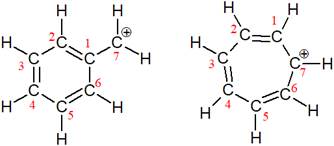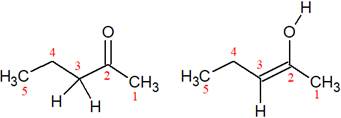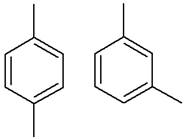
Concept explainers
(a)
Interpretation:
It is to be determined if the given pair is not resonance structures of one another.
Concept introduction:
Resonance exists in species for which there are two or more valid Lewis structures. Resonance structures differ only in the placement of their electrons, not their atoms. Resonance stabilization is usually high when the resonance contributors are equivalent. More the number of the resonance contributors, the more is the resonance stabilization.
Answer to Problem 1.75P
The given structures are not resonance structures of one another.
Explanation of Solution
The structures of the given pair are shown below:

The two structures have completely different carbon skeleton. The first one has a six membered ring while the second has a seven membered ring. Since these two structures do not have the same position of the atoms, they cannot be resonance structures.
From the position of atoms and electrons, it is found that the given pair is not resonance structures of one another.
(b)
Interpretation:
It is to be determined if the given pair is not resonance structures of one another.
Concept introduction:
Resonance exists in species for which there are two or more valid Lewis structures. Resonance structures differ only in the placement of their electrons, not their atoms. Resonance stabilization is usually high when the resonance contributors are equivalent. More the number of the resonance contributors, the more is the resonance stabilization.
Answer to Problem 1.75P
The given structure is not resonance structures of one another.
Explanation of Solution
The structures of the given pair are shown below:

In these two structures, the position of the hydrogen atoms is not the same. Hence, these structures cannot be resonance structures of each other.
From the position of atoms and valence electrons, it is found that the given pair is not resonance structures of one another.
(c)
Interpretation:
It is to be determined if the given pair is not resonance structures of one another.
Concept introduction:
Resonance exists in species for which there are two or more valid Lewis structures. Resonance structures differ only in the placement of their electrons, not their atoms. Resonance stabilization is usually high when the resonance contributors are equivalent. More the number of the resonance contributors, the more is the resonance stabilization.
Answer to Problem 1.75P
The given structure is resonance structures of one another.
Explanation of Solution
The structures of the given pair are as shown below.

To obtain the second resonance structure, two curved arrows are drawn and the electrons are moved accordingly. The two structures differ only in the placement of their electrons, not their atoms. Therefore, the given pair is resonance structures of one another.
From the position of atoms and valence electrons, it is found that the given pair is resonance structures of one another.
(d)
Interpretation:
It is to be determined if the given pair is not resonance structures of one another.
Concept introduction:
Resonance exists in species for which there are two or more valid Lewis structures. Resonance structures differ only in the placement of their electrons, not their atoms. Resonance stabilization is usually high when the resonance contributors are equivalent. More the number of the resonance contributors, the more is the resonance stabilization.
Answer to Problem 1.75P
The given structure is resonance structures of one another.
Explanation of Solution
The structures of the given pair are shown below:

To obtain the second resonance structure, two curved arrows are drawn and the valence electrons are moved accordingly. Similarly, to arrive at the third resonance structure, two curved arrows are drawn and valence electrons are moved accordingly. The resonance structures differ only in the placement of their electrons, not their atoms. Therefore, the given pair is resonance structures of one another.
From the position of atoms and valence electrons, it is found that the given pair is resonance structures of one another.
(e)
Interpretation:
It is to be determined if the given pair is not resonance structures of one another.
Concept introduction:
Resonance exists in species for which there are two or more valid Lewis structures. Resonance structures differ only in the placement of their electrons, not their atoms. Resonance stabilization is usually high when the resonance contributors are equivalent. More the number of the resonance contributors, the more is the resonance stabilization.
Answer to Problem 1.75P
The given structure is resonance structures of one another.
Explanation of Solution
The structures of the given pair are shown below:
![]()
To obtain the second resonance structure, a curved arrow is drawn and the valence electrons are moved accordingly. Similarly, to arrive at the third resonance structure, two curved arrows are drawn and valence electrons are moved accordingly. The resonance structures differ only in the placement of their electrons, not their atoms. Therefore, the given pair is resonance structures of one another.
From the position of atoms and valence electrons, it is found that the given pair is resonance structures of one another.
(f)
Interpretation:
It is to be determined if the given pair is not resonance structures of one another.
Concept introduction:
Resonance exists in species for which there are two or more valid Lewis structures. Resonance structures differ only in the placement of their electrons, not their atoms. Resonance stabilization is usually high when the resonance contributors are equivalent. More the number of the resonance contributors, the more is the resonance stabilization.
Answer to Problem 1.75P
The given structure is not resonance structures of one another.
Explanation of Solution
The structure of the given pair is as follows:

Resonance structures differ only in the placement of their electrons, not their atoms. In the given pair, the placement of electrons is the same. Therefore, the given pair is not resonance structures of one another.
From the position of atoms and valence electrons, it is found that the given pair is not resonance structures of one another.
(g)
Interpretation:
It is to be determined if the given pair is not resonance structures of one another.
Concept introduction:
Resonance exists in species for which there are two or more valid Lewis structures. Resonance structures differ only in the placement of their electrons, not their atoms. Resonance stabilization is usually high when the resonance contributors are equivalent. More the number of the resonance contributors, the more is the resonance stabilization.
Answer to Problem 1.75P
The given structure is not resonance structures of one another.
Explanation of Solution
The structure of the given pair is as follows:

Resonance structures differ only in the placement of their electrons, not their atoms. In the given pair, the placement of electrons is the same. Therefore, the given pair is not resonance structures of one another.
From the position of atoms and valence electrons, it is found that the given pair is resonance structures of one another.
(h)
Interpretation:
It is to be determined if the given pair is not resonance structures of one another.
Concept introduction:
Resonance exists in species for which there are two or more valid Lewis structures. Resonance structures differ only in the placement of their electrons, not their atoms. Resonance stabilization is usually high when the resonance contributors are equivalent. More the number of the resonance contributors, the more is the resonance stabilization.
Answer to Problem 1.75P
The given structure is not resonance structures of one another.
Explanation of Solution
The structure of the given pair is as follows:

Resonance structures differ only in the placement of their electrons, not their atoms. In the given pair, the placement of electrons is different; at the same time, one H atom changes its position. Therefore, the given pair is not resonance structures of one another.
From the position of atoms and valence electrons, it is found that the given pair is not resonance structures of one another.
Want to see more full solutions like this?
Chapter 1 Solutions
EBK ORGANIC CHEMISTRY: PRINCIPLES AND M
- presented by Morallen Lig Intermine the hand product for the given mution by adding atoms, bonds, nonhonding diarion panda скуль Step 3: Comp the draw the product Step 2: Agama workup Compithe 429 ملولةarrow_forwardReaction A 0,0arrow_forwardpresented by Morillon Leaning Predict the organic product for the min кусур HSC Adithane carved arnown to come than that to the condon slchroruis in acid in in aquishri with ноюarrow_forward
- 6.15PM Sun Mar 30 K Draw the major product of this reaction. Include any relevant stereochemistry. Ignore inorganic byproducts. Problem 1 of O H [PhзPCH2CH3]*C|¯ NaH Drawing > Q Atoms, Bonds and Draw or tap a nearrow_forward8:17 PM Sun Mar 30 Draw the major product of this reaction. Ignore inorganic byproducts. HSCH2CH2CH2SH, BF3 Probler Drawing Ato Bonds Clarrow_forwardpresented by Mr L How the coprion. (Il Done in no wraction, dew the starting redential) доarrow_forward
- 8:16 PM Sun Mar 30 K Draw the major product of this reaction. Ignore inorganic byproducts. Proble 1. CH3MgBr 2. H3O+ F Drawingarrow_forwardо но оarrow_forwardName the major organic product of the following action of 4-chloro-4-methyl-1-pentanol in neutral pollution 10+ Now the product. The product has a molecular formula f b. In a singly hain, the starting, material again converts into a secule with the molecular kormula CIO. but with comply Draw the major organic structure inhalationarrow_forward
- Macmillan Learning Alcohols can be oxidized by chromic acid derivatives. One such reagent is pyridinium chlorochromate, (C,H,NH*)(CICTO3), commonly known as PCC. Draw the proposed (neutral) intermediate and the organic product in the oxidation of 1-butanol by PCC when carried out in an anhydrous solvent such as CH₂C₁₂. PCC Intermediate OH CH2Cl2 Draw the intermediate. Select Draw Templates More с H Cr о Product Draw the product. Erase Select Draw Templates More H о Erasearrow_forwardIf I have 1-bromopropene, to obtain compound A, I have to add NaOH and another compound. Indicate which compound that would be. A C6H5 CH3arrow_forwardProvide the reagents for the following reactions.arrow_forward
 World of Chemistry, 3rd editionChemistryISBN:9781133109655Author:Steven S. Zumdahl, Susan L. Zumdahl, Donald J. DeCostePublisher:Brooks / Cole / Cengage Learning
World of Chemistry, 3rd editionChemistryISBN:9781133109655Author:Steven S. Zumdahl, Susan L. Zumdahl, Donald J. DeCostePublisher:Brooks / Cole / Cengage Learning Chemistry: The Molecular ScienceChemistryISBN:9781285199047Author:John W. Moore, Conrad L. StanitskiPublisher:Cengage Learning
Chemistry: The Molecular ScienceChemistryISBN:9781285199047Author:John W. Moore, Conrad L. StanitskiPublisher:Cengage Learning

